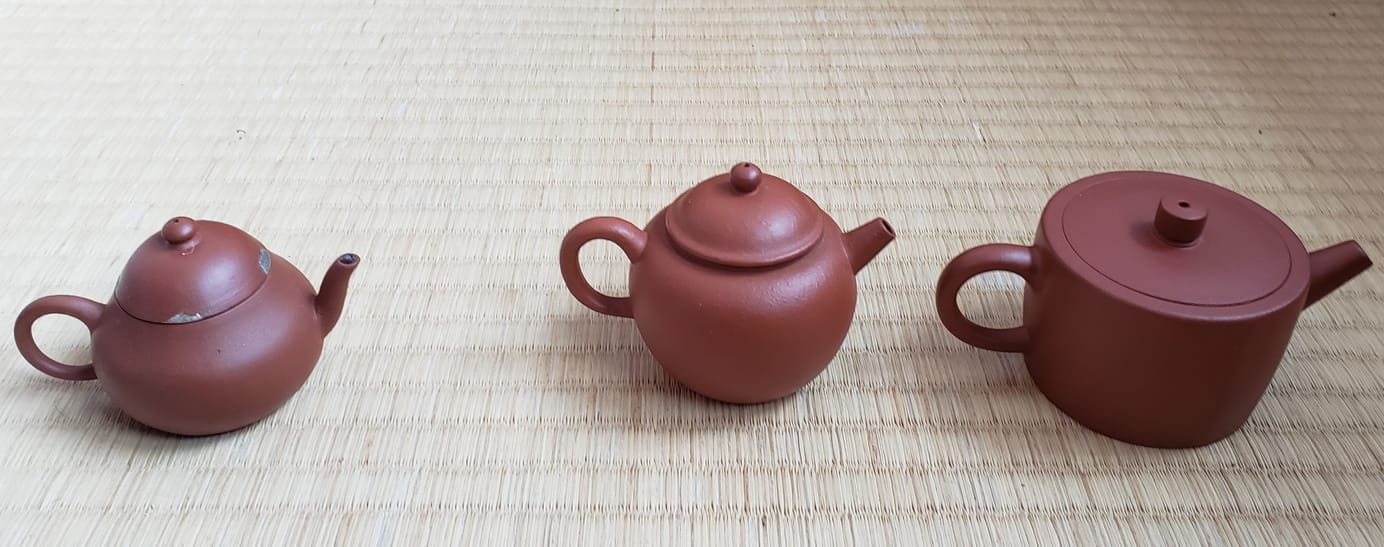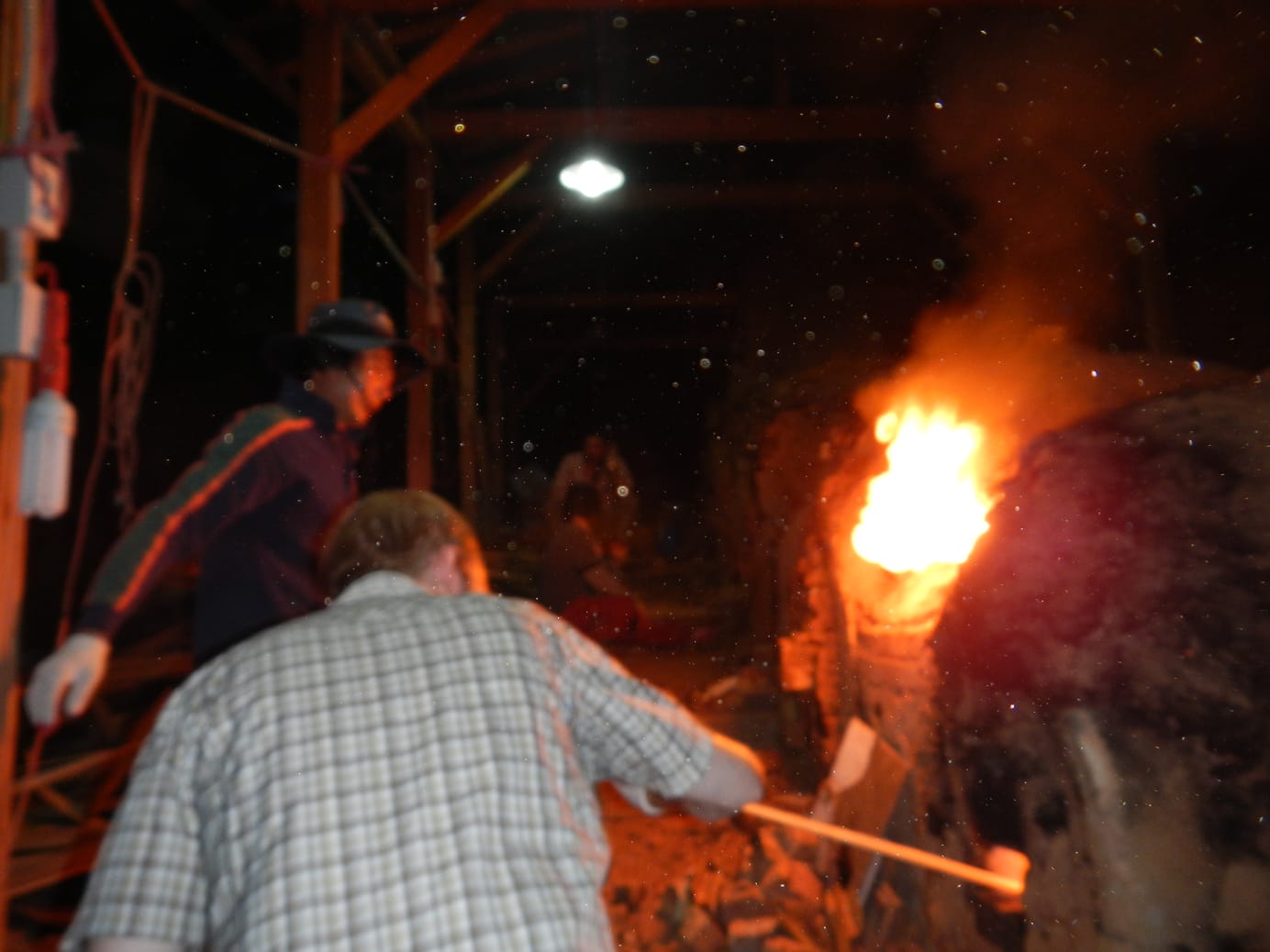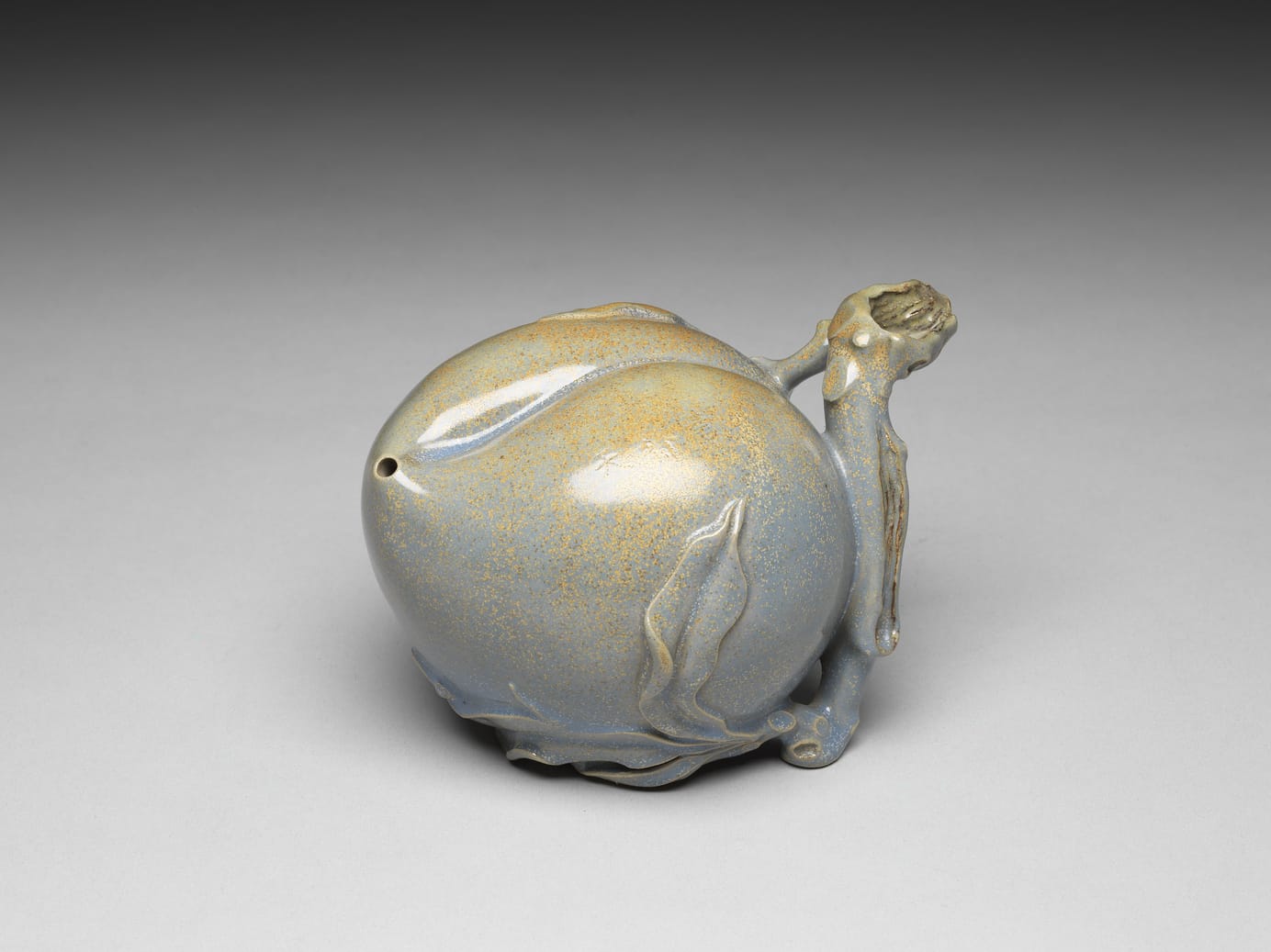
Editorial Conversation: Chapter 8, Section 7: Zhuni Ore and Clay
The episode is also available on YouTube and Spotify.
A full transcript is included on the episode page and below:
[00:00:00] Jason Cohen: Hello everyone, I'm Jason Cohen, the author of An Introduction to the Art and Science of Chinese Tea Ceremony. Today we're discussing Book 2, Chapter 8, Section 7, Zhuni (朱泥) Ore and Clay. Here to talk about this chapter is our editorial team, Patrick Penny.
[00:00:20] Pat Penny: Hey, hey!
[00:00:21] Jason Cohen: And Zongjun Li.
[00:00:22] Zongjun Li: Hello.
[00:00:24] Jason Cohen: Hello, everyone.
How has the definition of zhuni (朱泥) changed over time, and why is there still debate as to the definition of zhuni (朱泥) ore?
[00:00:32] Zongjun Li: Zhusha (朱砂) was the very original name that people coined this specific type of clay back in the days. And at the time, people doesn't know too much about the formation or the chemical composition of this specific type of clay, unlike today. So for the longest time, people tend to call clays with similar color zhuni (朱泥) at large. And it was really until the modern days people start to really understand the formation of zhuni (朱泥) and how it's connection to nenni (嫩泥) and also the chemical composition compared to other types of clay with sometimes similar type of scheme, like some hongni (红泥) or even some zini (紫泥) as well.
[00:01:18] Pat Penny: Just building off that. I think, there, there's a few different naming schemes, which we've seen through time, people naming something zhuni (朱泥) based on the color of the unfired ore, you get zhuni (朱泥) based on the color of the fired clay, and then, we see different uses based on whether or not someone is a teapot user versus a teapot maker. So people, through the F1 period, are calling things that contains some blend maybe of zhuni (朱泥) and hongni (红泥), most likely hongni (红泥) pots, but you know, if you wanted to sell it for more, particularly as we got into the nineties and early two thousands, when zhuni (朱泥) is highly in demand by Taiwanese tea connoisseurs you probably would call something that's hongni (红泥) a zhuni (朱泥), right?
And I think often in Taiwan, as you mentioned in the chapter, things were basically called zhuni (朱泥) when they were just superior quality clays, regardless of whether or not they were actually weathered nenni (嫩泥). So I think in this book, you set out to define zhuni (朱泥) as weathered nenni (嫩泥) versus hongni (红泥), which it's been at different points in time confused to be a subtype of, which is in fact weathered baini (白泥).
[00:02:24] Jason Cohen: Does zhuni (朱泥) ore need to slack in water to be zhuni (朱泥)?
[00:02:27] Zongjun Li: That's almost a common understanding in the community for a long time. But, in our visit to Yixing, we heard some other opinions about certain types of zhuni (朱泥) not slacking in water, which sometimes being considered as higher quality by a ceramist in Yixing.
So I think the answer is maybe debatable, maybe not all zhuni (朱泥) slack in water but that's also up to our audience judgment.
[00:02:54] Pat Penny: We heard this from a few specific craftsmen, but I wonder if we were able to go out and talk to even more, not that we had the time, but interested on what we might hear next time we make our way out there. And if we could find some craftsmen or who are of a different mindset or camp as far as zhuni (朱泥) is concerned.
[00:03:11] Jason Cohen: How does the variations in weathering affect the material properties of zhuni (朱泥) ore?
[00:03:16] Pat Penny: Some of the more direct changes are changes in color to the ore, which can affect the fired color, but obviously firing temperature has a bigger impact on that. But, the different styles of weathering for zhuni (朱泥) can also really impact the texture of the fired teapot skin. You have a quote or a poem in this book about the texture of zhuni (朱泥) and texture has often been a defining characteristic in the past for zhuni (朱泥).
So different weatherings can definitely lead to different skin patterns.
[00:03:46] Zongjun Li: And also clay processing sometimes have a huge impact on the final texture and performance of zhuni (朱泥) too. You sometimes sift out larger chunks or particles from the clay resulting a very uniformic texture. And sometimes ceramists decided to add some zhuni (朱泥) grog or some different grit size of zhuni (朱泥) into the blend so that you have a more dynamic surface texture.
[00:04:10] Pat Penny: I think you importantly note in this chapter as well that there's a difference between the ore weathering and the clay weathering. The ore and the clay weathering are two very different things, as mentioned in previous chapters as well, but particularly because at least the classical thought or the broad thought on zhuni (朱泥) ore was that when it's put in water, it will slack. The type of weathering obviously was very different. But when we think about weathering for the ore versus the clay, there are 2 separate things. And one is obviously occurring in nature and can be happening unexposed at deeper layers of the rock bed and strata, or it could be happening exposed, which probably would have happened more likely in older times when there was exposed mine site, nenni (嫩泥) sites.
[00:04:53] Zongjun Li: And also sometimes semi exposed, which resulting in a blend of some, some nenni (嫩泥) versus some zhuni (朱泥) so it's pretty interesting if you think about that, because it's almost like a natural blend of different types of clay, which results a very interesting gradient of different color for zhuni (朱泥).
[00:05:10] Jason Cohen: Zhuni (朱泥) is often seen as more mythical and, I believe, prone to the hyperreal than other zisha clays. Why might this be the case?
[00:05:19] Pat Penny: I think a portion of it is the rarity of the ore itself. So I think you have a figure somewhere in here around four percent of all the zisha clay mined in Yixing is zhuni (朱泥) ore, so it's a very low amount.
I think hongni (红泥) was maybe double that. Ore rarity, I think definitely plays into part of the mythical status.
[00:05:40] Zongjun Li: Yeah, definitely. And also the name being "vermilion", people will have a natural connection with Taoism. And I think that adds some, subconsciously valuable notion to people's mind.
[00:05:52] Pat Penny: I think also some of naming structures for zhuni (朱泥) that we've seen in the past, merchant groups in Taiwan just calling basically their best hongni (红泥) pots zhuni (朱泥) or saying zhuni (朱泥) as basically a superlative has also caused some of that perception.
[00:06:06] Zongjun Li: Yeah. Zhu, naturally, the character is a higher status among all the "hong", like all the red.
So I think there's some kind of consumer cognition that's playing in this game.
[00:06:20] Pat Penny: It's an S tier red.
It's S tier red.
[00:06:22] Jason Cohen: Does Da Hong Pao (大红袍) zhuni (朱泥) exist?
[00:06:25] Pat Penny: Depends on who's selling the teapot.
[00:06:30] Jason Cohen: It's a good answer. Would you buy a Da Hong Pao (大红袍) zhuni (朱泥) teapot?
[00:06:34] Pat Penny: No, I would not. Nor would I buy Da Hong Pao (大红袍) of any other clay.
[00:06:39] Jason Cohen: You wouldn't buy a Da Hong Pao (大红袍) hongni (红泥)?
[00:06:41] Pat Penny: I'm willing to and taste tea out of any pot. But I have a feeling that just adding Da Hong Pao (大红袍) to anything adds a zero, where it may not be warranted.
[00:06:50] Zongjun Li: Yeah, honestly, anything with the name Da Hong Pao (大红袍), I would put a question mark on it. Even Da Hong Pao (大红袍) tea.
[00:06:58] Jason Cohen: But it's the merchant's best, Zongjun.
Is zhuni (朱泥) more special than any other zisha clay in any way? Is it just rarity and the confusion around names that have made it so prone to eulogizing and mythologizing, or is there something that inspired all of that focus on this one specific Zisha clay.
[00:07:20] Pat Penny: A good zhuni (朱泥) teapot is a goddamn good pot. We all own some of the same zhuni (朱泥) teapots but many of us have had chances to use antiques. I think Zongjun and I might not have too many of those in our collection, but we've had a chance to use many and they do have material effects on tea that are highly desired. So there is a reason I think, for all of the hoopla around zhuni (朱泥). I just think that because there was amazing effects attributed to it, it just slowly snowballed into something more than what it really is. But it's certainly worthy of going out and adding a few zhuni (朱泥) to your collection.
[00:07:58] Zongjun Li: I think the difficulty of building one zhuni (朱泥) tea pot also played into a pretty significant role. Because the stickiness, thickness, and the high shrinkage rate, which resulting in a very high crackage rate during firing for zhuni (朱泥), really made it, difficult to construct basically. It's not just the rarity of the clay, but also the rarity of the pot itself.
And also because of the difficulty of building such teapot, I think a lot of the higher level ceramists consider zhuni (朱泥) as like a challenge for them to construct teapot for. So some of the higher artistic value teapot are sometimes made by zhuni (朱泥).
[00:08:37] Jason Cohen: That was something that I wanted to hit on. You believe that because the artistry was more difficult with zhuni (朱泥) that it was taken on. And because the zhuni (朱泥) ore was rare, which made it more expensive, it created this nice, positive feedback cycle where the nicest pots were made by the best artists in zhuni (朱泥) clay.
[00:08:55] Zongjun Li: Yeah. I think there's a compounding effect of multiple factors.
[00:09:00] Pat Penny: Reverse causation.
[00:09:02] Jason Cohen: Do either of you use and collect zhuni (朱泥)?
[00:09:05] Pat Penny: Collect is a strong word for me. Definitely use. I, as you both know, I'm buying a house, so I'm not currently seeking out antique zhuni (朱泥). But I do have a couple of zhuni (朱泥) pots and we were just discussing a little bit earlier, before recording, just how good those pots are.
We have pots that Jason, you commissioned from a craftsman, and I use those pots for everything and they have such great effect, but I have a few other zhuni (朱泥) in my collection and all I'm quite happy with. Low porosity, quite a high firing, and they still do have an effect on tea.
It's not like they're porcelain. But the muting is much lower on all of my zhuni (朱泥) tea pots than some of my zini (紫泥), for example. And so I can really get a lot of depth and clarity from almost any tea that I want to put into those pots.
[00:09:47] Zongjun Li: Yeah, clarity and also sometimes a lot of magnifying effect of certain attributes that I really like. Some roastage notes from some higher roast Oolong is what I really like to put into a zhuni (朱泥) teapot.
[00:10:01] Jason Cohen: You own, of course, the same commissioned piece. Do you own other zhuni (朱泥) wares or is that the only zhuni (朱泥) teapot you own?
[00:10:07] Zongjun Li: I think I need to start building up my zhuni (朱泥) collection as you guys do, but it's a little expensive to commit.
[00:10:14] Pat Penny: I think all of my zhuni (朱泥) is from that same potter that I bought from when I was there in April.
So, I only have maybe two other pieces beyond the ones that we have commissioned. So I'm in the same camp as you, Zongjun. I think once I start buying more pots again, zhuni (朱泥) will probably be on the list.
[00:10:30] Zongjun Li: I'm glad it's not a long way to catch up.
[00:10:34] Pat Penny: Well, if we're playing catch up, we both got a long way to catch up with Jason on zhuni (朱泥).
[00:10:40] Jason Cohen: Wistfully staring here at the collection. Speaking of my collection. I have antique zhuni (朱泥) in my collection. What proportion of the clay is actually zhuni (朱泥)?
[00:10:50] Pat Penny: You mean that you, in the one week that's passed since our hongni (红泥) chapter, you haven't developed the skill to touch the teapot and immediately, from your fingertips, feel all the information stored within the clay and know the exact blend proportion?
You haven't learned how to do that?
[00:11:06] Jason Cohen: This is antique Qing.
[00:11:08] Pat Penny: For the listeners at home, Jason's touching the teapot. His fingers are telling him everything he needs to know.
[00:11:13] Jason Cohen: And I'm getting less than 100%, I'm getting less than 100 percent zhuni (朱泥).
[00:11:18] Zongjun Li: Oh, geez. Wow.
[00:11:20] Pat Penny: What a surprise. That teapot looked beautiful by the way.
As you wrote in the book, we all... I don't want to say fetishized, but we all really love zhuni (朱泥), antique zhuni (朱泥). But we know that even though we call these pots antique zhuni (朱泥), it's almost a hundred percent likely that they are not fully zhuni (朱泥) teapots and that they are a blend of either zhuni (朱泥) with hongni (红泥), zhuni (朱泥) with nenni (嫩泥) or some other zisha clay, zhuni (朱泥) blended with more pre fired zhuni (朱泥). So there's a lot of different variations on what it could be, but it's very unlikely that any pot you have that is zhuni (朱泥) is pure zhuni (朱泥) unless it's modern.
[00:11:53] Zongjun Li: Yeah. Even with the modern technique, the crackage rate for firing zhuni (朱泥) can be as high as 40 percent in a batch.
So in the past people tend to add zhuni (朱泥) grog or other materials to strengthen the structuring integrity of zhuni (朱泥) when it gets fired.
[00:12:11] Jason Cohen: Is there an argument against using, say, cooked zhuni (朱泥) grog? If you have broken zhuni (朱泥) teapots, you remill, you crush and remill the pre fired zhuni (朱泥) material and you add that back into raw zhuni (朱泥). Is there an argument against that? Is that detrimental to the teapot even if it helps survivability?
[00:12:31] Pat Penny: We've heard one such argument from a craftsman that we spend some time with in Yixing. I know you got the exact quote, I can't quite find it right here in front of me, but he basically said that it dulls the original flavor of the ore. So by adding back pre fired ore, there's something that is special about that original fired ore that is being lost when you add back pre fired grog. Now, whether or not that's true, I don't know.
[00:12:58] Zongjun Li: Yeah, he used the word "cooked" which is really a flavor note that you want to avoid when you brew tea in a teapot. It's a cooked flavor.
[00:13:07] Jason Cohen: It was an interesting argument. I've never heard anyone speak against using pre cooked grog previously, pre fired grog.
It's a fairly common technique in Western ceramics, a fairly common technique in other ceramic artistry. And to hear, okay all of these teapots are cracking in the kiln, you just grind them up and reuse some of the material. And he's like, absolutely not. No. That is bad.
And only bad teapots are made from pre cooked clay. I'd not heard that argument before.
[00:13:33] Pat Penny: I just sell it to all the other teapot makers who will make bad teapots.
[00:13:37] Zongjun Li: At the same time the artist also claimed that certain zhuni (朱泥) doesn't slack in water. So maybe he was just using that specific type of zhuni (朱泥), which doesn't require adding grog to have zhuni (朱泥) have a stronger structural integrity during building.
[00:13:55] Jason Cohen: Are all zhuni (朱泥) blends acceptable as zhuni (朱泥) teapots? Pat, you mentioned zhuni (朱泥) and hongni (红泥), but say, is zhuni (朱泥) and duanni (段泥), is that okay?
[00:14:06] Pat Penny: I don't think there's anything that's not okay. It just depends, I think, on what you're being sold. If you're just being told it's a zhuni (朱泥) teapot and it's in fact, 25 percent zhuni (朱泥), 75 percent duanni (段泥), it might be nice to know what you're buying, right?
[00:14:21] Jason Cohen: It's the opposite.
[00:14:22] Pat Penny: 75, 25. I think honestly, I'd probably be pretty happy. A 75 percent zhuni (朱泥) teapot, that sounds pretty good to me. If it's sold as just a zhuni (朱泥) teapot, I think I'd probably be happy.
[00:14:32] Jason Cohen: So a zhuni (朱泥) duanni (段泥) blend, majority zhuni (朱泥) is okay.
Zongjun, do you think that's strange or would you buy that, if you knew what it was.
[00:14:41] Zongjun Li: It's a little strange of a combination and also like
[00:14:44] Pat Penny: You had the price point to match though.
[00:14:46] Zongjun Li: You really have to put into the mind that different types of clay doesn't necessarily have a very similar center temperature range.
So sometimes, certain additional clay might not be fired properly, when you blend the clays together. I'm not sure.
[00:15:03] Pat Penny: I'm trusting in my craftsman that he's blended, a good blend that has both made his life easier for moldability, fire-ability and will make my life as a teapot user better, but it sounds like I'm trusting.
[00:15:15] Zongjun Li: This is 17 percent duanni (段泥), like, why is this teapot leaking?
[00:15:22] Jason Cohen: Underfired duanni (段泥). This is why you have to go to Yixing and meet your Yixing merchant in person and test the teapots before you buy.
[00:15:30] Pat Penny: We're keeping the barrier to entry on using Yixing's real low. Just go to Yixing and meet your teapot maker and then you'll be fine.
[00:15:38] Jason Cohen: Read the thousand page book, go to Yixing, meet the teapot maker.
[00:15:43] Pat Penny: Don't even start with Yixing until you've got at least 20k in the bank to break on Yixing's.
[00:15:48] Jason Cohen: Study Chinese for 10 years.
[00:15:50] Pat Penny: Super accessible hobbies.
[00:15:54] Jason Cohen: Many collectors only consider zhuni (朱泥) from Zhao Zhuang Shashan (赵庄沙山) as original. Do you consider zhuni (朱泥) from Baoshan (宝山) as Ben Shan (本山) as well or do you agree with these other collectors?
[00:16:04] Pat Penny: The material properties as we know them can slightly differ between the mine sites. However, I think, you have to take each zhuni (朱泥) teapot for what it is. You shouldn't just be, using a pot based on the ore and the clay type, right? You need to test them anyway.
So I think as long as you're getting the kind of results that you would expect and the performance you would expect from zhuni (朱泥), whether it's from Baoshan (宝山) or Zhao Zhuang (赵庄), if it's giving you zhuni (朱泥) like results, it's zhuni (朱泥). I think for me whether or not it comes from the original mine site is not a strong argument to me with whether or not it is truly zhuni (朱泥).
[00:16:43] Zongjun Li: Just like a lot of the tea, right? Sometimes people will consider certain region Ben Shan (本山). But sometimes there are multiple Ben Shans (本山) in a certain region. It's all really based on people's belief in the clay and the performance of certain clay and their relationship with geographic location.
I think that's really subjective in most cases. As long as the clay suffice your preference in brewing tea, I think it's good clay.
[00:17:10] Jason Cohen: For the record, I consider Baoshan (宝山) as Ben Shan (本山) for zhuni (朱泥). As long as it's zhuni (朱泥) ore and zhuni (朱泥) material, it's zhuni (朱泥). Do you find zhuni (朱泥) harder or easier to use than other zisha clays?
[00:17:26] Pat Penny: I think I actually find it easier. I think it's easier to hit a, at least an acceptable result. I think it can be harder to find the perfect result, but I think it is easier to find acceptable results with a zhuni (朱泥) teapot. You won't often have zhuni (朱泥) paired with something and go, oh, this is so dull or doesn't taste like anything, or, oh, this muted the hell out of the tea.
You might get some weird notes now and then. But generally it will perform as well as porcelain and sometimes way better.
[00:17:53] Zongjun Li: Yeah, I agree. And also zhuni (朱泥) tend to really magnify the flavor of a lot of tea, which it might be difficult to find good teas to uh, pair with your zhuni (朱泥) teapot.
If you put into a flower tea in the zhuni (朱泥) teapot, it will taste even worse.
[00:18:09] Pat Penny: Yeah, don't brew your odds and ends in zhuni (朱泥).
[00:18:11] Jason Cohen: Are there any special considerations to take when using zhuni (朱泥)?
[00:18:17] Pat Penny: My personal go tos, I think green oolong, as Zongjun mentioned, roasted oolong, aged puer, those are kind of things that I reach for zhuni (朱泥) for, but I think I would, once again, as we've said all throughout this book, test your pot with everything.
[00:18:30] Zongjun Li: And also when buying new pots, do examine the pot very carefully, because there might be sometimes minor flaws in the teapot that you want to avoid.
Zhuni (朱泥) is very delicate and sometimes, small crackage can be hard to notice.
[00:18:44] Pat Penny: That's a great one. Heat your pot. Zhuni (朱泥) loses heat faster than you'd expect.
[00:18:48] Zongjun Li: Yeah.
[00:18:49] Jason Cohen: Everyone, that's all the time that we have for today. Thank you for joining us in this edition of Tea Technique Editorial Conversations. Please join us again for our next conversation, Luni Ore and Clay.


